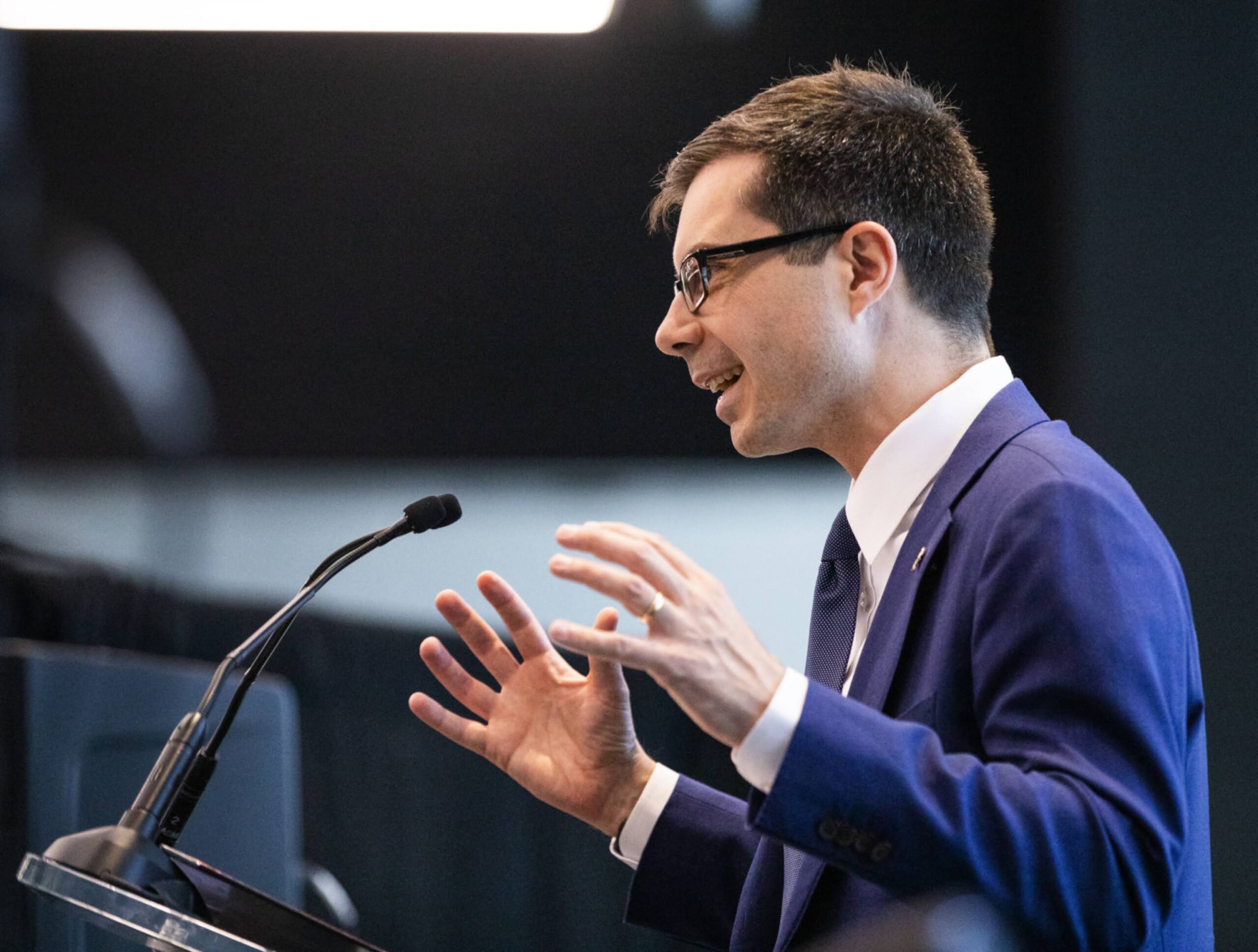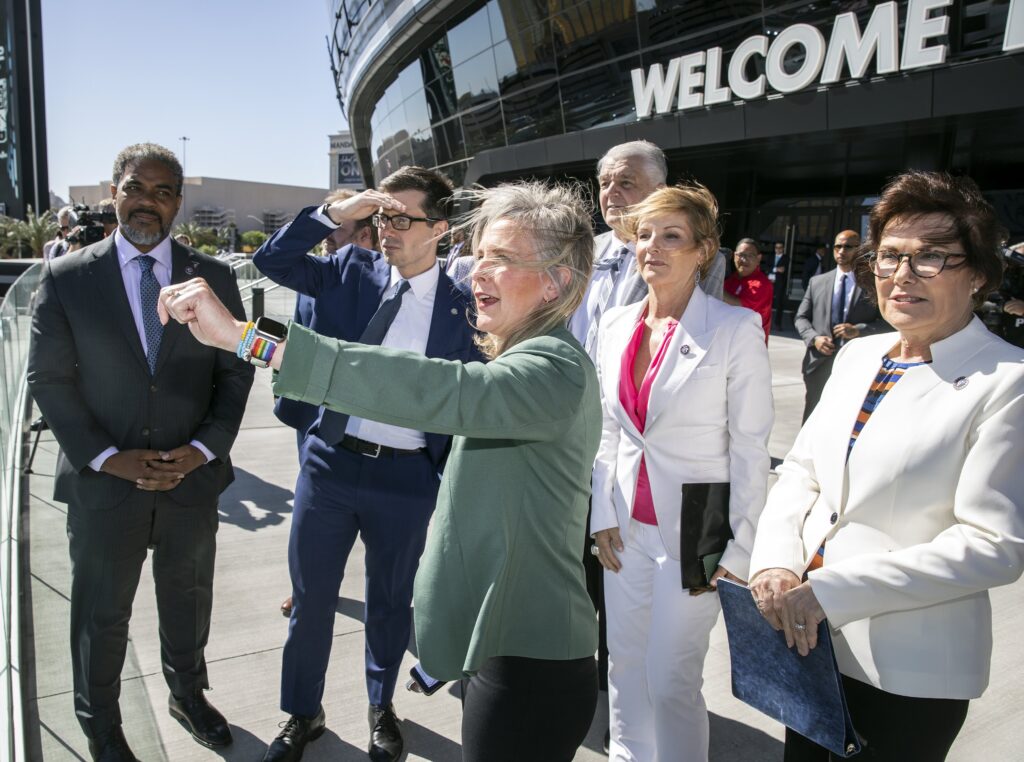Five infrastructure questions with U.S. Transportation Secretary Pete Buttigieg

After several years of “infrastructure week” jokes, Congress finally passed a sweeping infrastructure funding bill last November, paving the way for the first major investment in retooling, revamping (or completely rebuilding) the nation’s rapidly aging — and sometimes crumbling — network of roads, bridges and more.
As part of that bill, Nevada saw more than $3.5 billion secured through the next five years, with hopes for more money still outstanding as part of the normal competitive bidding process. That money includes more than $2.7 billion for highway and bridge repairs, as well as another $468 million for public transportation and nearly $300 million for airport infrastructure.
At the bill’s six-month anniversary (and after the announcement of a major revamp of the Interstate 15/Tropicana Avenue exit near the Las Vegas Strip), Transportation Secretary Pete Buttigieg sat down for an exclusive interview with The Nevada Independent to run through what the new funding means for Nevada.
Editor’s note: This transcript has been edited for clarity and length. You can listen to an audio version of this interview on next week’s edition of the IndyMatters Podcast, out anywhere you listen to podcasts on June 7.

The Nevada Independent: What is the day-to-day impact that Nevadans will see from this infrastructure bill? Both now, and in the next five years and beyond?
Buttigieg: The first thing you're going to see is a lot of construction jobs. We're getting to work swiftly on a lot of projects that are putting a lot of people to work. Then over time, of course, you see the projects completed and then you see benefits in terms of safety, in terms of convenience, in terms of being able to get to where you need to be.
The economic impact of infrastructure spending can't be overstated. Just today we celebrated the beginning of an interchange project that will directly be responsible for 4,600 jobs. And then indirectly, it will support countless more by making sure that people have the connections they need. And in this era when we're paying more attention as a country to supply chains than before, the ability to move goods more efficiently helps at a time like this when we're fighting inflation, and shipping costs are part of what goes into that. So it's really everything.
How would you characterize how much larger the pool of money is for infrastructure projects now, versus before the passage of this bill?
[There were] programs that had about a billion dollars each in them last year, and we had something like a 10-to-1 ratio between the applications that came in and the ones we were able to fund. And there were many deserving projects that we couldn't support just because there weren't enough dollars to go around.
We have considerably more money going into those funds right now. In addition to the wholly new programs that have been created … add these all up and what it comes to is the biggest investment that we have made in our transportation infrastructure since the Eisenhower administration.
For transit, it's the most we've ever done for highways. It's the most we've done since they set up the interstate highway system in the first place. For rail, it is the most we've done since Amtrak was stood up 50 years ago. And that's frankly, [that’s] what it's going to take to bring our infrastructure back into good repair and to be ready for the future.
How will the bill address serious transportation, shipping and supply chain disruptions, like those that emerged during the pandemic?
Look, our supply chains largely consist of private operations, but they happen over public infrastructure. In other words, the truck driver or the shipping company or the warehouse operator might be a private company, but the roads, the bridges, the ports that they are depending on are often public.
We have got to make those public investments so that our infrastructure systems are more resilient, that way when you have a shock, when you have a disruption, whether it's a pandemic, a climate disaster, or something else, we're better able to adapt to it. A lot of underinvestment for the last 40-50 years caught up to us in the last couple.
What’s the federal government’s role in shaping what policy ought to look like — such as safety policy, for instance — by picking and choosing project funding through the bidding process?
Sometimes it's something seemingly small, like lighting or crosswalks, or it could be the complete redesign of a dangerous interchange, which is a bigger project. But there are a number of things that we know we need to do with real investment to make transportation in this country safer.
When it comes to climate, we have a carbon reduction program now that will go through the states to enable them to fund projects that are going to help, whether that means a more efficient design that's going to have less idling and congestion, or something that's going to support less carbon-intensive means of getting around.
There's always going to be a back and forth with the states to do the lion's share. The money goes to the states to decide which things they want to fund, and then our department will select which ones we want to fund in the competitive programs — sending a signal about some of the most promising investments that we think everybody should take a look at.
So in the scope of these decisions being made by states, rather than the federal government — is it up to the federal government to finally get a train between California and Nevada?
For something like that to happen, you need to have a partnership that involves states working together, sometimes even a private partner or purpose-built public sector entity and us, the federal government, there to help.
In fact, a lot of the big projects we're seeing right now, mega-projects we call them, are a bridge or a rail line or something else that cuts across state lines. And that's why we need to make sure that we're not siloed or bureaucratic, in terms of how we go about supporting it.
I grew up in an area that was close to a state line between Indiana and Michigan. And growing up, you didn't really pay very close attention to when you were in this municipality or district or county or state. You just expected your community to work for you. And we need to think regionally more often when it comes to delivering these big pieces of infrastructure.
Editor’s Note: This story appears in Indy 2022, The Nevada Independent’s newsletter dedicated to comprehensive coverage of the 2022 election. Sign up for the newsletter here.
